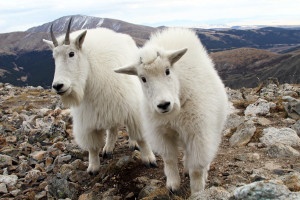 Mountain goats were first introduced to Colorado in the collegiate mountain range in the 1940’s and have had a stable population ever since. Originally there was concern that these animals were exotic and might compete with the native big horn sheep, but the two species have been peacefully coexisting ever since the introduction. Researchers recently have debated that mountain goats might have been native to Colorado once before. Regardless of their past, wildlife enthusiasts and common passersby who get a glimpse of these animals have welcomed their presence for many decades.
Mountain goats were first introduced to Colorado in the collegiate mountain range in the 1940’s and have had a stable population ever since. Originally there was concern that these animals were exotic and might compete with the native big horn sheep, but the two species have been peacefully coexisting ever since the introduction. Researchers recently have debated that mountain goats might have been native to Colorado once before. Regardless of their past, wildlife enthusiasts and common passersby who get a glimpse of these animals have welcomed their presence for many decades.
Despite their common name, mountain goats are more closely related to the African antelope and European chamois than the true goats and sheep we are familiar with. These specially adapted animals will brave harsh conditions above tree line to avoid predators such as mountain lion, bear, wolf, and coyote. To tolerate such conditions, the mountain goat’s thick coat consists of two layers. The wooly under layer insulates while the coarse, hollow guard hairs protect the animal from extreme temperatures. Steep and rocky terrain also comes with the territory. To keep these animals as sure-footed as they are, the bottom of their hoofs are “spongy” to provide ample traction on such treacherous terrain. Unlike other hoofed animals, the hoofs on a mountain goat spread outward with each step to increase traction and surface contact. Unfortunately, even these special adaptations cannot prevent fatal falls. Rock slides and avalanches are the greatest threat to a mountain goat.
July is a special time of year to observe Mountain Goats. The mothers (nannies) can be seen throughout the high alpine zones of Colorado as they raise their young (kids). Mountain goats begin mating between November and December. Billies will woo their potential mate by staring for long periods of time and then slowly approaching, sometimes even crawling across the ground just to get a little closer. Nannies are very territorial, so moving in too fast could make her aggressive rather than flattered. Billies will compete with each other, but with such sharp horns and steep terrain, physical contact can turn fatal. Instead, billies pose in a dominating stance to ward off the competitor. The billie with the more threatening pose will stand his ground while the other will show defeat by cowering away. The mating ritual is timed so that nannies can welcome their kids in the more hospitable months of May and June. Within hours of birth, the kids will begin walking, or at least attempt to. During these fragile times, nannies will position themselves in front of a cliff edge to prevent any clumsy falls as the kid learns how to maneuver. Nannies usually have one kid per litter with occasional twins. Kids will stay with their mother until the next breeding season and can live 12-15 years in the wild.
As we enter mid-summer, mountain goat terrain becomes easier to access. Look for white hair caught on branches as the mountain goats shed their thick winter coats. Mountain goats may be seen near campsites as they search to supplement their diet with salts. Some have even been reported digging around latrines and licking hand railings. If you are wondering where to go for a chance to see these amazing animals, I have a few recommendations. Mt. Evans, Grays Peak, Torreys Mountain, the Gore Range near Dillon, the Collegiate Mountain Range, and the Weminuche Wilderness in the San Juan Mountains are all great places to check out. These places have wildlife viewing areas accessible by car and many trails to hike. For more wildlife viewing information, the national forest information centers have pamphlets specifically for viewing mountain goats and big horn sheep. Happy viewing!
Marshall Kohls is a Naturalist for Walking Mountains Science Center in Avon. He has a special interest in animal adaptations and the mountains.









